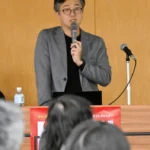Mount Asahi in the Daisetsuzan mountain range observed its first snowfall on October 9th.
As winter approaches, preparations for the cold season are steadily underway in Sapporo.
The faint white snow covering the mountaintop belongs to Mount Asahi in the Daisetsuzan range.
Cold air typical of early November moved in, leading to the first observed snowfall.
The first snowfall on Mount Asahi was recorded 14 days later than the average year.
Meanwhile, frost formed in the morning at the Ishikari-Tokachi Pass connecting Kamikawa and Kitami.
Due to the influx of cold air on the morning of the 9th, even lowland areas experienced single-digit minimum temperatures.
In Nukabira, Kamishihoro, car windshields completely froze over from the cold, requiring scraping efforts since morning.
The gradual approach of winter is becoming noticeable.
Preparations for winter have begun before the cold intensifies.
In Sapporo, kerosene deliveries are being carried out.
One household reportedly used their heater for the first time on the 8th due to the morning chill.
“Since it’s getting colder, I thought it was about time. I turned on the portable heater yesterday because the morning was cold.”
Although kerosene orders are still fewer compared to typical years, they are gradually increasing as autumn deepens.
“This morning was 5-6°C, so with the chilliness, it feels like winter is really coming. Many customers are calling to prepare in advance.”
Home improvement stores are also ramping up their winter product campaigns to welcome the cold season warmly.
“This is the heater corner. The slim design helps reduce unused space, and the combustion part generates less soot, making maintenance easier.”
Slim heaters are performing better compared to previous years.
Sales have already reached 1.2 times those of 2024.
There’s also this item—
“At first glance, this looks like an ordinary dining table, but if you lift the foot area, it’s actually a kotatsu that gently warms from inside.”
It’s a table-type kotatsu that consumes less electricity while providing warmth.
It’s particularly popular among elderly people who find sitting on the floor uncomfortable for their legs.
“With rising utility and fuel costs becoming an issue, there’s growing demand for compact heating appliances that can warm specific areas to create comfortable personal spaces.”
Winter’s approach is becoming audible in Hokkaido.
This cold weather is expected to continue for a while, making early preparations necessary.
Upcoming Cold Weather
Sapporo’s minimum temperature on October 9th was 9.5°C, reaching single digits.
This cold spell is expected to continue. Looking at the weekend forecast, maximum temperatures will stay below 20°C, while minimum temperatures may drop below 10°C on some days.
Many people will likely be going out during the three-day weekend, so please take proper measures against the cold by bringing coats when heading outside.
Mount Asahi
Mount Asahi, also known as Asahidake, is the highest peak in Hokkaido, Japan, reaching 2,291 meters. It is part of the Daisetsuzan National Park and is a dormant volcano with a history of eruptions, the most recent occurring approximately 5,000 years ago. Today, it is a popular destination for hiking and skiing, renowned for its scenic volcanic landscapes and hot springs.
Daisetsuzan mountain range
The Daisetsuzan mountain range is the largest national park in Japan, located on the northern island of Hokkaido. Its name, meaning “great snowy mountains,” reflects its vast, high-altitude landscapes, which are considered sacred in the Ainu indigenous culture. The park was established in 1934 to protect its unique volcanic peaks, alpine flora, and diverse wildlife.
Sapporo
Sapporo is the capital of Hokkaido, Japan’s northernmost prefecture, which was officially developed from the late 19th century during the Meiji period. The city is famously home to the annual Sapporo Snow Festival and is a major hub for the region, renowned for its beer, ramen, and its role in hosting the 1972 Winter Olympics. Its modern, grid-patterned layout reflects its planned origins as a new administrative center.
Ishikari-Tokachi Pass
The Ishikari-Tokachi Pass is a scenic mountain pass in Hokkaido, Japan, connecting the Ishikari and Tokachi regions. Historically, it served as a vital transportation and trade route for the indigenous Ainu people. Today, it is known for its panoramic views, especially the vibrant autumn foliage.
Kamikawa
Kamikawa is a town located in Hokkaido, Japan, situated in the Kamikawa Basin and known as the gateway to the Daisetsuzan National Park. Historically, it developed as a transportation hub and settlement for pioneers during Hokkaido’s development period in the late 19th and early 20th centuries. Today, it is a popular base for outdoor activities like hiking and skiing, surrounded by scenic volcanic landscapes.
Kitami
Kitami is a city located in the northern part of Hokkaido, Japan. Historically, it developed in the early 20th century through industries like mint farming and later became a major center for the production of peppermint. Today, it is known for its onion production and as a gateway to the nearby Shiretoko Peninsula, a UNESCO World Heritage site.
Nukabira
I am unable to find any significant historical or cultural information about a place named “Nukabira.” It is possible this refers to a very localized or lesser-known site, or there may be a spelling variation. For an accurate summary, verifying the correct name and location would be necessary.
Kamishihoro
Kamishihoro is a town located in Hokkaido, Japan, known for its scenic landscapes and agricultural heritage. Historically, its development accelerated in the early 20th century with the establishment of settlements and farms, contributing to Hokkaido’s pioneering era. The area is also recognized for its connection to the Japanese internment camps during World War II, where Allied prisoners of war were held.




